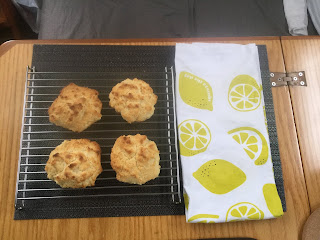New Mast Winch
We added a self-tailing winch at the mast on the starboard side. This makes raising the mainsail and handling reefs easier as this winch can be operated with only one hand. The winch is a two-speed Andersen 26 ST in all stainless steel and it replaced a Lewmar 18. It is a beauty! Because the winch is powerful with a 26:1 reduction gear, it also is very useful for winching a person up the mast, and we have already tested it! Cheryl pulled me the mast a couple of weeks ago with little effort.
Andersen 26ST Winch on the Right (Starboard)
Forward Water Tank
We connected the forward water tank to the manual pump in the head and this increased our water capacity by 18 gallons (68 liters). We also installed an access port and calibrated a wooden dowel that we use as a dipstick so we know exactly how much water is in the tank at any time. The forward water tank is located in the forward cabin under the bunk. The tank is now connected to the manual pump in the head/vanity.
Forward Water Tank Access Port and Connections
Manual Pump (Right) Connected to Forward Water Tank
Securing Spare Anchor and Rode
We secured the panel covering the V-berth storage bin with webbing to prevent the spare anchor and rode from getting loose. The spare anchor is a 33 lb (15 kg) Bruce and we have over 200 ft (60 m) of rode plus 110 ft (34 m) of chain stored under the V-berth. Securing the panel is necessary as these items are heavy and if they get loose they can cause potentially significant injuries to the crew and damage to Rosalind.
Forward Bunk Anchor and Rode Storage - Water Tank located under Anchor
Straps to Secure Forward Under-Bunk Panel
Over the winter, we also purchased a folding cart to help with provisioning and carrying heavy items around when on shore. This a heavy duty cart rated for 275 lbs (125 kg) and has 8 inch (20 cm) diameter wheels. The cart is stored in the aft cabin on the aft end of the starboard bunk. We also secured the cart with a strap. The bunk has become a dedicated storage for large items such as the cart, storm jib, cruising spinnaker, and stand-up paddle board (SUP). This year, the cushion for that bunk was left at home.
Folding Cart Stored - Aft Cabin Starboard Bunk (Looking Aft)
Here is a sketch of Rosalind's main cabin looking aft. Under the settee are the battery selector switches and the panel that controls the propane sensor. Above the aft settee, are the barometer, the ship's clock, the VHF radio, and the main electrical panel. Outboard of the electrical panel (to port) is a bookcase. The red and white pennant with the letter B hanging in front of the mirror is from our favorite restaurant "Boatyard Bar and Grill", in Annapolis MD. The table is setup for two, however it can unfold to accommodate four. Above the table, we have a hanging wine glass rack. The overhead brass cabin light has both white and red LED lights. Red is used when we are on passage and the very bright white is used when we are in port or at anchor and we want lots of light. A brass oil lamp is hanging from the overhead. We can use if we do not want to use electricity or if we want to take the chill off on a cool evening. There is also a small brass LED reading light above the table between the storage bins.
Rosalind's Salon (Looking Aft)














